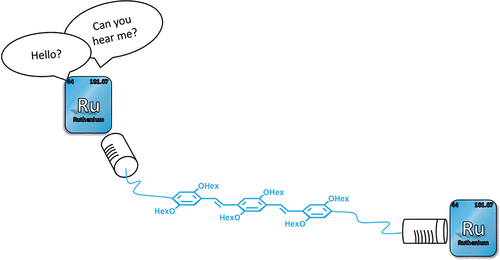
Check out Franci's second Paper
This study presents dinuclear alkenylruthenium complexes featuring π-extended trans,trans-distyrylbenzene or 1,4-(2-phenylethynyl)benzene linkers, analogous to oligophenylvinylene and oligophenylethynylene oligomers, as well as the macrocyclic analogue. Characterized by NMR spectroscopy and high-resolution ESI-MS, the compounds undergo detailed examination of their electrochemical and spectroscopic properties. The study explores the efficacy of intramolecular through-bond electron transfer in their mixed-valent, one-electron-oxidized radical cations using UV/vis/NIR and EPR spectroscopy, density functional theory calculations, and IR spectroscopy, revealing charge localization and delocalization dynamics on different timescales.
We report on dinuclear alkenylruthenium complexes with π-extended trans,trans-distyrylbenzene (1-V) or 1,4-(2-phenylethynyl)benzene (1-A) linkers akin to oligophenylvinylene and oligophenylethynylene oligomers (OPV-3 and OPE-3, respectively) and the macrocylic analogue 2-A. All compounds were characterized by NMR spectroscopy and high-resolution ESI-MS. Their electrochemical and spectroscopic properties were examined. The efficacy of intramolecular through-bond electron transfer in their mixed-valent, one-electron-oxidized radical cations was probed by UV/vis/NIR and EPR spectroscopy as well as by density functional theory calculations. The terminally appended diruthenium tags of the present compounds add IR spectroscopy to the available toolbox and provide resolved hyperfine splittings to the 31P nuclei in the EPR spectra of their one- and two-electron-oxidized radical cations and dications. Our results indicate charge localization on one {Ru}–CH═CHAr site on the IR time scale for [1-A]•+ and [2-A]••2+ and a small degree of charge delocalization in [1-V]•+. On the slower time scale of EPR spectroscopy, [1-V]•+ and [1-A]•+ become valence-detrapped or nearly so. The near breakdown of electronic coupling on fast time scales is also indicated by the finding that the chromophores present in [1-V]•+ and [1-V]2+, in [1-A]•+ and [1-A]2+, and in [2-A]••2+ and [2-A]4+ are mutually identical. Read more here
